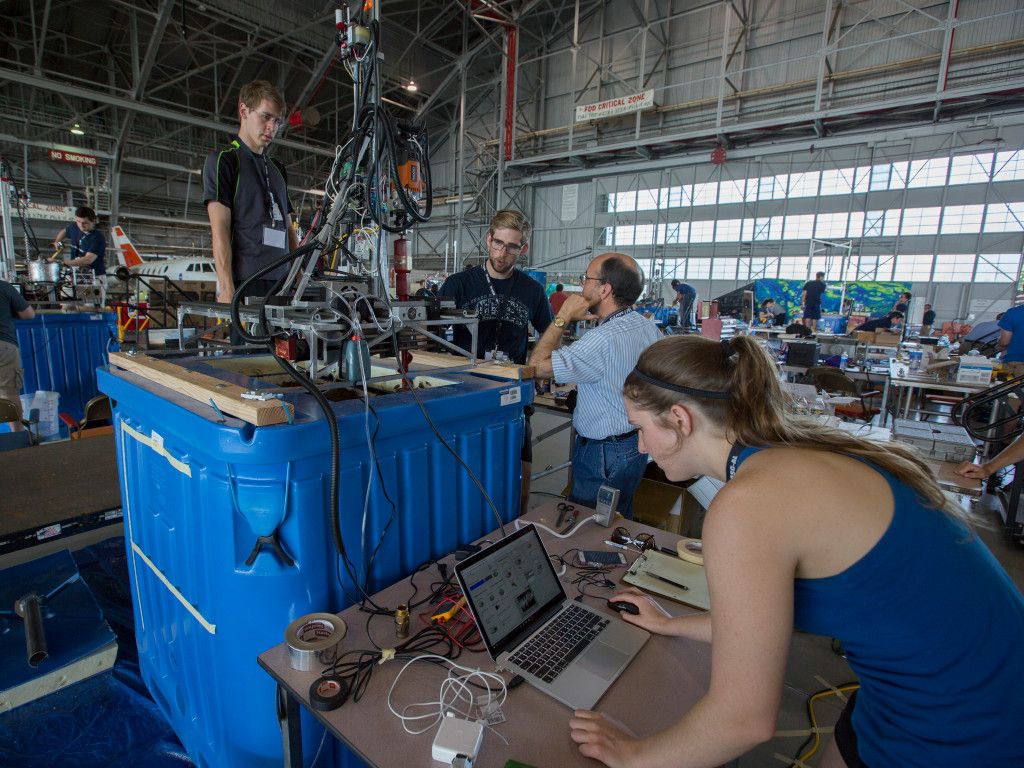
Category: space – Page 1,050

CTA Prototype Telescope, the SST-1M, Catches its First Glimpse of the Sky
On Thursday, 31 August, 2017, a prototype telescope proposed for the Cherenkov Telescope Array (CTA), the SST-1M, recorded its first events while undergoing testing at the Institute of Nuclear Physics Polish Academy of Sciences (IFJ-PAN) in Krakow, Poland. The SST-1M is proposed as one of CTA’s Small-Sized Telescopes (SSTs), which will cover the high end of CTA’s energy range, between about 1 and 300 TeV (tera-electronvolts).
A crew in Krakow worked for two days to install the camera on the telescope and spent another two days monitoring it to ensure it could be safely switched on in the high humidity conditions. Watch the camera installation in the video below.



Sun Unleashes Monster Solar Flare, Strongest in a Decade
Early this morning (Sept. 6), the sun released two powerful solar flares — the second was the most powerful in more than a decade.
At 5:10 a.m. EDT (0910 GMT), an X-class solar flare — the most powerful sun-storm category — blasted from a large sunspot on the sun’s surface. That flare was the strongest since 2015, at X2.2, but it was dwarfed just 3 hours later, at 8:02 a.m. EDT (1202 GMT), by an X9.3 flare, according to the National Oceanic and Atmospheric Administration’s Space Weather Prediction Center (SWPC). The last X9 flare occurred in 2006 (coming in at X9.0).


Scientists Make It Rain Diamonds In The Lab
The first time and only time I’ve been to the United States was when I carried out a summer placement at the SLAC National Accelerator Laboratory. To get there, I had to have an interview at the U.S. embassy, where when asked what I was going to do in the U.S. I said that I’d be making diamonds. My interviewer laughed at me. But it was true, that was the experiment I was going to help out with. And now, a research collaboration of scientists from all over the world have, for the first time, created “diamond rain” in the laboratory to mimic the conditions of the interiors of icy giant planets. Dominik Kraus, scientist at Helmholtz Zentrum Dresden-Rossendorf, described this work as “one of the best moments of my scientific career.”
Icy giant planets like Neptune and Uranus in our solar system, are planets with a gaseous atmosphere and a rocky core surrounded by a dense slush of different ices. The ices are generally hydrocarbons made of heavier elements including oxygen, carbon, sulfur and nitrogen bonded to hydrogen. Under extremely high pressures, diamond rain can be seen deep inside their interiors. This occurs when the hydrogen and carbon are squeezed by extreme pressures to form solid diamonds. They then slowly sink towards the center of the icy giant forming a layer around the rocky core, just like rain sinks in our atmosphere towards the surface of Earth.

School of Mines hopes to launch first-ever space mining program
The Colorado School of Mines is no longer concerned with just earthly matters.
The world-renowned science and engineering institution in Golden is now eyeing asteroids, the moon, Mars and beyond to explore, extract, process and use the raw materials they provide to help sustain life in space.
Mines hopes to launch a first-of-its kind interdisciplinary graduate program in space resources in 2018, pending approval by school leaders. The first course, Space Resources Fundamentals, is being offered as a pilot program this fall.

Scientists Finally Prove Strange Quantum Physics Idea Einstein Hated
The equations of physics are things that we humans created to understand the Universe, and it can be hard to disentangle them from the Universe’s innate properties. It turns out that one of the weirdest things scientists have come up with, what Albert Einstein derisively called “spooky action at a distance,” is more than just math: It’s a fact of reality.
That concept is also known as entanglement, and it’s what allows particles that have once interacted to share a connection regardless of the separation between them. A team of physicists in the United Kingdom used some dense mathematics to come to their Einstein-angering conclusion, taking an important step towards proving whether quantum mechanics’ weirdness is just the math talking, or whether it speaks to innate physical requirements. Their mathematical proof’s main assumption is that any new physics theory should be backward-compatible with the physics you learned in high school.